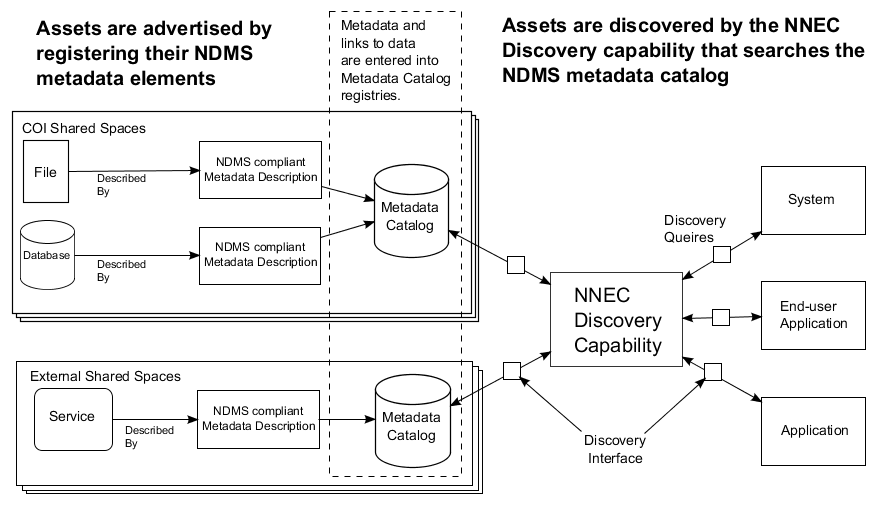Appendix A. Technologies
40. This annex describes the technologies that are projected to be available today or in the near term period which will enable the transformation towards the NII.
A.1. Data Strategy
A.1.1. Data Management Strategy
41. Reference: TBD
A.1.2. JC3IEDM
42. The JC3IEDM is a merger of both the LC2IEDM (Land C2 IEDM, developed by the Multitlateral Interoperability Programme (MIP)) and the NATO Reference Data Model, which was developed by a predecessor of the DMSWG. The JC3IEDM is published under cover of STANAG 5525.
43. Since DMSWG is responsible for Data Administration not only for the JC3IEDM but also for any other Standard Information Exchange Mechanisms (Adat-P3 messages, Tactical Data Links, XML technologies, etc.) within NATO, it will also register and manage both the Standard Data Elements and the Information Exchange Requirements (IER) used in the development process of any of those mechanisms. DMSWG will as well publish Directive and Guidance documents for Data Administration in NATO.
44. As main tools for the Data Administration process, DMSWG has been tasked to develop and maintain both the NATO Metadata Registry and the NATO XML Registry. The objective is to implement them both with COTS products, in a single system called NATO Metadata Registry and Repository, which would integrate both functionalities. A version of the NATO XML Registry is currently posted under the DoD XML Registry.
A.1.3. NATO Discovery Metadata Specification (NDMS)
45. The NDMS defines discovery metadata elements for resources posted to NATO shared spaces. "Discovery" is the ability to locate data assets through a consistent and flexible search method. The NDMS specifies a set of information fields that are to be used to describe any data or service asset that is made known to NATO, and it serves as a reference for developers, system architects, and engineers by identifying a minimum set of metadata elements in support of Discovery Services. Whilst discovery of data assets is the primary use of the NDMS it is also important to note that widespread use of the metadata elements will also improve documents record management in general. The NDMS will be employed consistently throughout the organization but it is not intended or necessary for it to displace other specifications that offer different semantics.
46. To support data asset discovery, NATO has developed the NDMS as the common set of descriptive metadata elements that are to be associated with each data asset that is made visible to the enterprise discovery capability. Metadata is often defined as being "data that describes and defines other data". Data assets available in the enterprise must be described with metadata, using the elements defined in this document to permit discovery through the enterprise discovery capability. The NDMS defines a minimum set of elements that must be used to describe data assets made visible to the enterprise. Users and system agents acting on their behalf that search the enterprise will discover data assets that have been tagged and entered into catalogues or repositories that respond to search queries specified in terms of NDMS entries as depicted in the NDMS Usage Conceptual Diagram in Figure A.1.

Figure A.1. NDMS Usage Conceptual Diagram
47. The elements specified in the NDMS are designed to be platform, language, and implementation independent. This allows system developers to generate and retain discovery metadata using any implementation approaches, including using COTS products. As future enterprise discovery interface specifications are defined, programs should have the appropriate discovery metadata available for their data assets and will only be required to format this metadata in accordance with the interface specifications.
A.1.4. Extensible Markup Language (XML)
48. The Extensible Markup Language (XML) is a simple, very flexible text format, much like HTML, used to structure, store and to send information. XML was designed to describe data and to focus on what data is. XML is also playing an increasingly important role in the exchange of a wide variety of data on the Web and elsewhere.
49. Role of XML in the Web Services model is lies within communication. When one application talks to another to perform a web service, the application doing the talking must package the message it is sending in a format that is understandable by the listening application. XML is the format of the message content in this communication process.
50. The Extensible Markup Language tags provide information about a document's components. The Uniform Resource Identifiers contained in the XML tags expand the concept of Uniform Resource Locators (URLs) by adding IDs for objects, concepts and values that are not dependent on location.